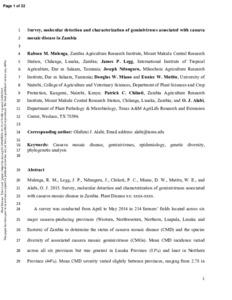| dc.contributor.author | Mulenga, R.M. |
| dc.contributor.author | Legg, J.P. |
| dc.contributor.author | Ndunguru, J. |
| dc.contributor.author | Miano, D.W. |
| dc.contributor.author | Mutitu, E.W. |
| dc.contributor.author | Chikoti, Patrick Chiza |
| dc.contributor.author | Alabi, O.J. |
| dc.date.accessioned | 2019-12-04T11:04:03Z |
| dc.date.available | 2019-12-04T11:04:03Z |
| dc.date.issued | 2016-07 |
| dc.identifier.citation | Mulenga, R.M., Legg, J., Ndunguru, J., Miano, D.W., Mutitu, E.W., Chikoti, Patrick Chiza & Alabi, O.J. (2016). Survey, molecular detection and characterization of geminiviruses associated with cassava mosaic disease in Zambia. Plant Disease, 100(7), 1379-1387. |
| dc.identifier.issn | 0191-2917 |
| dc.identifier.uri | https://hdl.handle.net/20.500.12478/1325 |
| dc.description.abstract | A survey was conducted from April to May 2014 in 214 farmers’ fields located across six major cassava-producing provinces (Western, Northwestern, Northern, Luapula, Lusaka, and Eastern) of Zambia to determine the status of cassava mosaic disease (CMD) and the species diversity of associated cassava mosaic geminiviruses (CMG). Mean CMD incidence varied across all six provinces but was greatest in Lusaka Province (81%) and least in Northern Province (44%). Mean CMD severity varied slightly between provinces, ranging from 2.78 in Eastern Province to 3.00 in Northwestern Province. Polymerase chain reaction discrimination of 226 survey samples, coupled with complete DNA-A genome sequence analysis, revealed the presence of African cassava mosaic virus (ACMV), East African cassava mosaic virus (EACMV), and East African cassava mosaic Malawi virus (EACMMV) as single or mixed infections of different proportions. Single-virus infections were predominant, occurring in 62.8% (ACMV), 5.8% (EACMMV), and 2.2% (EACMV) of samples relative to mixed-virus infections, which occurred in 19.5% (ACMV + EACMMV), 0.4% (ACMV + EACMV), and 0.9% (ACMV + EACMV + EACMMV) of samples. Phylogenetic analysis revealed the segregation of virus isolates from Zambia into clades specific to ACMV, EACMV, and EACMMV, further confirming the presence of all three viruses in Zambia. The results point to a greater diversity of CMG across major cassava-growing provinces of Zambia and implicate contaminated cassava cuttings in disease spread. |
| dc.format.extent | 1379-1387 |
| dc.language.iso | en |
| dc.subject | Geminiviruses |
| dc.subject | Epidemiology |
| dc.subject | Genetic Variation |
| dc.subject | Cassava |
| dc.title | Survey, molecular detection and characterization of geminiviruses associated with cassava mosaic disease in Zambia |
| dc.type | Journal Article |
| dc.description.version | Peer Review |
| cg.contributor.crp | Roots, Tubers and Bananas |
| cg.contributor.affiliation | Zambia Agricultural Research Institute |
| cg.contributor.affiliation | International Institute of Tropical Agriculture |
| cg.contributor.affiliation | Mikocheni Agricultural Research Institute, Tanzania |
| cg.contributor.affiliation | University of Nairobi |
| cg.contributor.affiliation | Texas A&M University |
| cg.coverage.region | Africa |
| cg.coverage.region | Southern Africa |
| cg.coverage.country | Zambia |
| cg.isijournal | ISI Journal |
| cg.authorship.types | CGIAR and developing country institute |
| cg.iitasubject | Cassava |
| cg.iitasubject | Plant Diseases |
| cg.journal | Plant Disease |
| cg.howpublished | Formally Published |
| cg.accessibilitystatus | Limited Access |
| local.dspaceid | 79147 |
| cg.targetaudience | Scientists |
| cg.identifier.doi | https://dx.doi.org/10.1094/PDIS-10-15-1170-RE |

